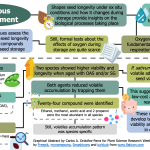Plant Science Research Weekly: May 14th, 2021
Review: Recent discoveries show novel sensors and regulation of reactive oxygen species
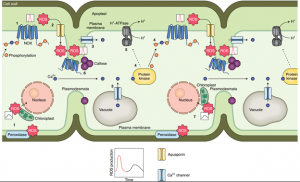 Reactive Oxygen Species (ROS) are produced as metabolic byproducts and are vital participants in development and stress responses. However, ROS can be damaging, and are subcellularly localized to mitigate toxicity. Perception of pathogen attack leads to apoplastic ROS production through Respiratory Burst Oxidase Homologs (RBOHs), which in turn leads to transduction of immune signaling. Perception of ROS likely occurs through redox modifications such as the oxidation of cysteines on ROS-interacting proteins. In Arabidopsis, the receptor-like kinase Hydrogen-Peroxide-Induced Ca2+ Increases 1 (HPCA1) has been implicated in direct sensing of H2O2, a common ROS molecule. H2O2 modifies cysteines in the unique hydrogen peroxidase domain of HPCA1, resulting in stomatal closure. There are likely other ROS sensors in addition to HPCA1, as this protein is not involved in stomatal closure in response to common microbial elicitors. Post translational modifications (PTM) of RBOHs can modulate the ROS response through altered protein capabilities and stability. The amino termini of RBOHs are activation sites, which are phosphorylated in response to stress and other stimuli. The carboxyl terminus is a site of both activating and inhibitory PTMs, including ubiquitination causing RBOH degradation. The localization, sensing, and production of ROS are tightly regulated to produce a dynamic balance between cellular function and oxidative damage. (Summary by Marlo Hall @marloXplants). Nature Plants 10.1038/s41477-021-00887-0
Reactive Oxygen Species (ROS) are produced as metabolic byproducts and are vital participants in development and stress responses. However, ROS can be damaging, and are subcellularly localized to mitigate toxicity. Perception of pathogen attack leads to apoplastic ROS production through Respiratory Burst Oxidase Homologs (RBOHs), which in turn leads to transduction of immune signaling. Perception of ROS likely occurs through redox modifications such as the oxidation of cysteines on ROS-interacting proteins. In Arabidopsis, the receptor-like kinase Hydrogen-Peroxide-Induced Ca2+ Increases 1 (HPCA1) has been implicated in direct sensing of H2O2, a common ROS molecule. H2O2 modifies cysteines in the unique hydrogen peroxidase domain of HPCA1, resulting in stomatal closure. There are likely other ROS sensors in addition to HPCA1, as this protein is not involved in stomatal closure in response to common microbial elicitors. Post translational modifications (PTM) of RBOHs can modulate the ROS response through altered protein capabilities and stability. The amino termini of RBOHs are activation sites, which are phosphorylated in response to stress and other stimuli. The carboxyl terminus is a site of both activating and inhibitory PTMs, including ubiquitination causing RBOH degradation. The localization, sensing, and production of ROS are tightly regulated to produce a dynamic balance between cellular function and oxidative damage. (Summary by Marlo Hall @marloXplants). Nature Plants 10.1038/s41477-021-00887-0
Review: One cell, many signatures: Organellar Ca2+ signaling
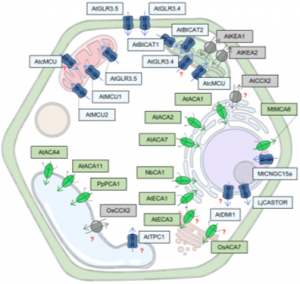 Calcium ions (Ca2+) occupy a primary position in plant cell signaling processes by virtue of their role as the so-called second messengers. Ca2+ signaling underlies plant response to various abiotic, biotic and developmental cues. Whilst this Ca2+ signaling was thought to predominantly occur in the cytoplasm, recent studies have established its occurrence in many other cell organelles. Here, Resentini and colleagues reviewed the importance of organellar Ca2+ signaling in a host of cellular signaling processes. The authors dissected genetic evidence of proteins involved in the generation and transduction of Ca2+ signals in various organelles and their contribution in shaping plant responses to abiotic, biotic and developmental stimuli. Importantly, the authors differentiated Ca2+ signals generated in an organelle from an organelle acting as a source or sink for cytosolic Ca2+ signaling, highlighting the complexity underlying cellular Ca2+ signaling events. In addition to underscoring the importance of organellar Ca2+ signaling, this update points to open questions about Ca2+ signaling and sets the stage for future studies to probe the synergistic action of cytosolic and organellar Ca2+ signaling in shaping plant responses. Note: This update is dedicated to the memory of Prof. Hillel Fromm (Tel Aviv University, Israel) whose contribution to the field of Ca2+ signaling will always be remembered. (Summary by Pavithran Narayanan @pavi_narayanan) Plant Physiol. 10.1093/plphys/kiab189
Calcium ions (Ca2+) occupy a primary position in plant cell signaling processes by virtue of their role as the so-called second messengers. Ca2+ signaling underlies plant response to various abiotic, biotic and developmental cues. Whilst this Ca2+ signaling was thought to predominantly occur in the cytoplasm, recent studies have established its occurrence in many other cell organelles. Here, Resentini and colleagues reviewed the importance of organellar Ca2+ signaling in a host of cellular signaling processes. The authors dissected genetic evidence of proteins involved in the generation and transduction of Ca2+ signals in various organelles and their contribution in shaping plant responses to abiotic, biotic and developmental stimuli. Importantly, the authors differentiated Ca2+ signals generated in an organelle from an organelle acting as a source or sink for cytosolic Ca2+ signaling, highlighting the complexity underlying cellular Ca2+ signaling events. In addition to underscoring the importance of organellar Ca2+ signaling, this update points to open questions about Ca2+ signaling and sets the stage for future studies to probe the synergistic action of cytosolic and organellar Ca2+ signaling in shaping plant responses. Note: This update is dedicated to the memory of Prof. Hillel Fromm (Tel Aviv University, Israel) whose contribution to the field of Ca2+ signaling will always be remembered. (Summary by Pavithran Narayanan @pavi_narayanan) Plant Physiol. 10.1093/plphys/kiab189
Review: Chronoculture: improving crop yield and sustainability by exploiting the plant circadian cycle ($)
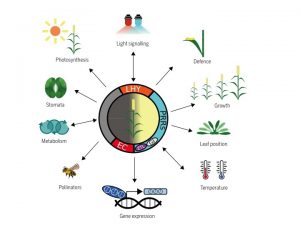 The circadian cycle affects almost all eukaryotic cells. In the case of plants, circadian rhythms affect many processes including the supply of carbon during the night for respiration and growth, and many other agricultural traits. The use of this knowledge for adapting agronomic practices or to alter circadian rhythms in crops through breeding and gene editing has been described as “chronoculture,” just as considering the impact of time of day on human biology is called “chronomedicine”. Early farmers and breeders looking for higher yields indirectly selected loci related to the circadian cycle, many of which are associated with the regulation of flowering; optimized time of flowering can optimize yields by avoiding abiotic stresses later in the season. Similarly, tweaking the time of day at which stomata are open can improve water use efficiency. Plant defenses can be tuned to the times of day at which their pathogens and pest are most dangerous, and fertilizer and pesticides have been found to be more efficient when applied at specific times of the day. The rich knowledge of the molecular control of plant circadian clocks and responses provide ample opportunities to improve crop yields through chronoculture. (Summary by Cecelia Vasquez-Robinet) Science 10.1126/science.abc9141
The circadian cycle affects almost all eukaryotic cells. In the case of plants, circadian rhythms affect many processes including the supply of carbon during the night for respiration and growth, and many other agricultural traits. The use of this knowledge for adapting agronomic practices or to alter circadian rhythms in crops through breeding and gene editing has been described as “chronoculture,” just as considering the impact of time of day on human biology is called “chronomedicine”. Early farmers and breeders looking for higher yields indirectly selected loci related to the circadian cycle, many of which are associated with the regulation of flowering; optimized time of flowering can optimize yields by avoiding abiotic stresses later in the season. Similarly, tweaking the time of day at which stomata are open can improve water use efficiency. Plant defenses can be tuned to the times of day at which their pathogens and pest are most dangerous, and fertilizer and pesticides have been found to be more efficient when applied at specific times of the day. The rich knowledge of the molecular control of plant circadian clocks and responses provide ample opportunities to improve crop yields through chronoculture. (Summary by Cecelia Vasquez-Robinet) Science 10.1126/science.abc9141
Review: Postzygotic reproductive isolation established in the endosperm: mechanisms, drivers and relevance ($)
 In this fascinating review, Köhler and colleagues show us that the seed endosperm is not only a nutritive tissue that supports embryo growth, it also nourishes the course of plant evolution. When closely related species or species with different ploidy levels hybridize, endosperm development deviates from its standard pattern and impedes the proper formation of the embryo. In the first case, defects in endosperm formation arise from differences in the endosperm balance number (i.e., the effective ploidy level in the endosperm of a given species). In species with different ploidy levels, the defective endosperm development is attributed to a mechanism known as the “triploid block”. Current evidence suggests that genomic imprinting plays a significant role in both mechanisms. For instance, studies carried in Arabidopsis thaliana have shown the participation of genes preferentially expressed in either pollen grain (such as PHERES1) or the egg cell (MEDEA) in establishing these barriers. Some of the genes seem to interact with the auxin biosynthesis pathway, a well-known regulator of endosperm development. As a result, this is an obligate reading for anyone interested in the role of seed endosperm in reproductive isolation, the molecular basis behind it, and its implications for angiosperm evolution. (Summary by Carlos A. Ordóñez-Parra @caordonezparra) Phil. Trans. R. Soc. B. 10.1098/rstb.2020.0118
In this fascinating review, Köhler and colleagues show us that the seed endosperm is not only a nutritive tissue that supports embryo growth, it also nourishes the course of plant evolution. When closely related species or species with different ploidy levels hybridize, endosperm development deviates from its standard pattern and impedes the proper formation of the embryo. In the first case, defects in endosperm formation arise from differences in the endosperm balance number (i.e., the effective ploidy level in the endosperm of a given species). In species with different ploidy levels, the defective endosperm development is attributed to a mechanism known as the “triploid block”. Current evidence suggests that genomic imprinting plays a significant role in both mechanisms. For instance, studies carried in Arabidopsis thaliana have shown the participation of genes preferentially expressed in either pollen grain (such as PHERES1) or the egg cell (MEDEA) in establishing these barriers. Some of the genes seem to interact with the auxin biosynthesis pathway, a well-known regulator of endosperm development. As a result, this is an obligate reading for anyone interested in the role of seed endosperm in reproductive isolation, the molecular basis behind it, and its implications for angiosperm evolution. (Summary by Carlos A. Ordóñez-Parra @caordonezparra) Phil. Trans. R. Soc. B. 10.1098/rstb.2020.0118
Gaseous environment modulates volatile emission and viability loss during seed artificial ageing
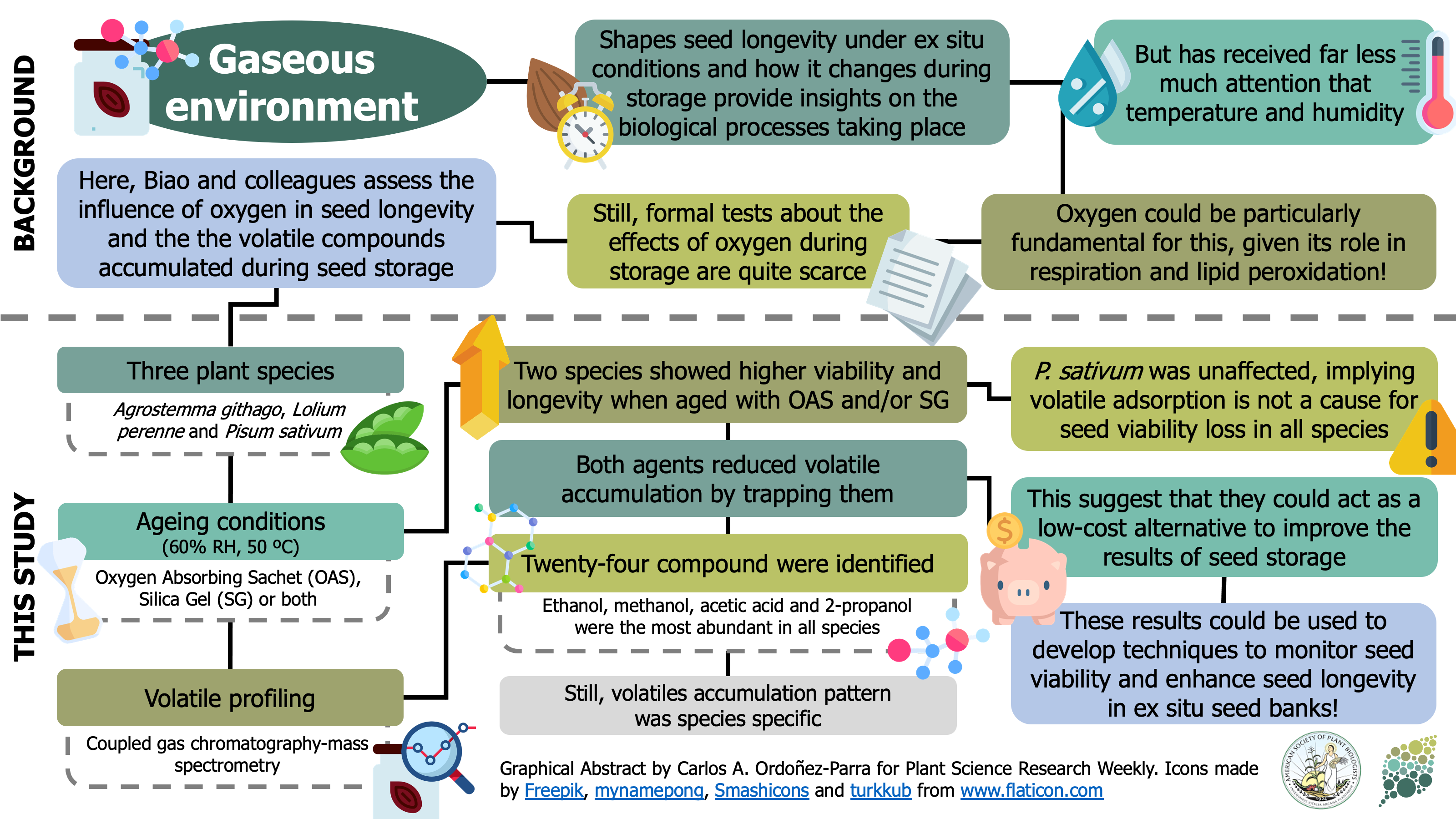 The gaseous environment is thought to play a fundamental role in seed longevity in storage conditions, given the role of oxygen and other volatile compounds in seed viability loss. However, formal tests of its influence are still scarce compared to other storage parameters such as temperature and humidity. In this paper, Han and colleagues assess the effect of oxygen on seed longevity and the volatile compounds accumulated during seed storage. Seeds of three species were submitted to an accelerated aging treatment in the presence of Oxygen Absorbing Sachets (OAS), silica gel (SG), or both. Volatile compound emission was analyzed using coupled gas chromatography-mass spectrometry. Seed viability and lifespan of two species were higher when seeds were aged with OAS and/or SG. Twenty-four volatile substances were identified, with ethanol, methanol, and acetic acid the most prevalent. Notably, volatile emission was reduced in seed incubated with OAS or SG, suggesting they act as volatile traps. This paper provides promising results that could be implemented in techniques to keep track of seed viability and storage practices that enhance seed longevity in ex-situ seed banks. (Summary by Carlos A. Ordóñez-Parra @caordonezparra) Planta 10.1007/s00425-021-03620-5
The gaseous environment is thought to play a fundamental role in seed longevity in storage conditions, given the role of oxygen and other volatile compounds in seed viability loss. However, formal tests of its influence are still scarce compared to other storage parameters such as temperature and humidity. In this paper, Han and colleagues assess the effect of oxygen on seed longevity and the volatile compounds accumulated during seed storage. Seeds of three species were submitted to an accelerated aging treatment in the presence of Oxygen Absorbing Sachets (OAS), silica gel (SG), or both. Volatile compound emission was analyzed using coupled gas chromatography-mass spectrometry. Seed viability and lifespan of two species were higher when seeds were aged with OAS and/or SG. Twenty-four volatile substances were identified, with ethanol, methanol, and acetic acid the most prevalent. Notably, volatile emission was reduced in seed incubated with OAS or SG, suggesting they act as volatile traps. This paper provides promising results that could be implemented in techniques to keep track of seed viability and storage practices that enhance seed longevity in ex-situ seed banks. (Summary by Carlos A. Ordóñez-Parra @caordonezparra) Planta 10.1007/s00425-021-03620-5



